|
|
|
©By: John T. Blair (WA4OHZ)
 1133 Chatmoss Dr., Va. Beach, Va. 23464; (757) 495-8229
1133 Chatmoss Dr., Va. Beach, Va. 23464; (757) 495-8229
Originally written: August 2008
Last update:  November 22, 2009.
November 22, 2009.
|
|
My old metal erector set, shed (10' wide x 8' deep) had seen it's better days. I had put the shed up on cinderblock piers and had the metal frame floor kit. The floor frame was covered with 3/4" plywood. The outside was rusting, and the plywood floor was collapsing. After about 10 years of use, it has served me well, and had been inexpensive storage.
I had helped my dad build a 10' wide by 12' deep vinyl shed some 5 years ago.
I was very impressed with the ease of assembly, and the idea of basically no maintenance! When we put up dad's shed, he used solid cinderblocks for a floor.
|
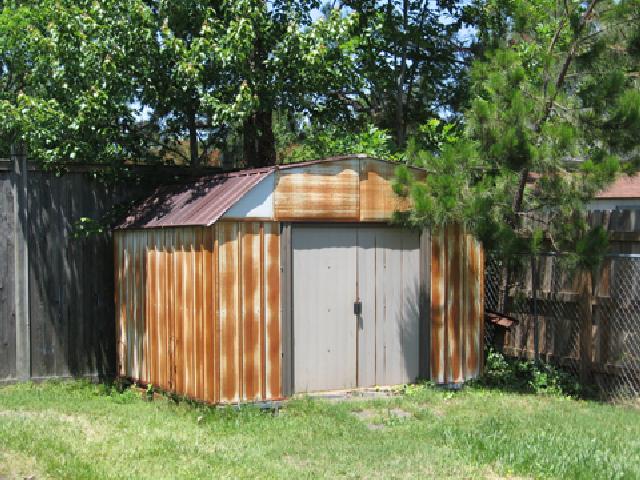 Old Arrow Erector Set Shed - served me well
Old Arrow Erector Set Shed - served me well
|
|
The back corner of my yard gets standing water during a heavy rain, consequently we wanted the base build up about 3 to 5 inches before we laid the floor.
I did a lot of looking and thinking about what I wanted for a new shed:
1. I'd like it larger - 10' wide x 12' deep
2. No maintenance
3. I'd have to raise it about 6" above the ground.
4. A solid floor, or at least not an elevated floor.
To meet these needs, I finally decided on:
A. A 10' wide by 12' deep vinyl shed. Meets requirements 1 and 2.
B. The back corner of my yard gets standing water when it rains. Consequently requirement 3,and why I had put the old shed up on piers. So I'd have to build up about 3 to 5 inches above the surrounding ground when the shed was to be placed. If I do that, I'd need someway to contain the fill and keep it from washing away.
My buddy, Dennis, said he could get me a dump truck of crush-n-run to build up the base.
To hold the base in place we decided to use 2 layers of garden timbers placed around the perimeter of the shed. But we needed a way to hold them in place. We decided to drill holes through the timbers and drive spikes (made from 2 foot lengths of Rebar) into the ground. That should hold things together.
C. For requirement 4, a strong solid floor, there were 2 choices, a concrete slab or cinderblocks. The most obvious choice would have been to have a concrete slab poured. However, in a lot of places, a concrete slab means it is a permanent fixture and would require a permit. I priced using the solid cinderblock and it was a little cheaper than having the slab poured, and didn't require getting a permit. So I opted for the block floor.
Now that I had a plan, so in October of 2007 I went looking for a new vinyl shed. No one could sell me on in October. They said, sheds are seasonal. I really wanted to work on putting it up in the fall, winter and or spring, when it was cool. No such luck. Finally, the beginning of March 2008, stores started to advertise their new sheds. So I went looking. It took me about 24 days to find the shed I really wanted, someone that had a clue about the Royal Vinyl shed (10'W x 12' deep) I wanted, and a company that would sell me one.
Finally March 24 ordered and paid for the shed and the associated materials: some landscape timbers and about 170 solid cinderblocks.
|
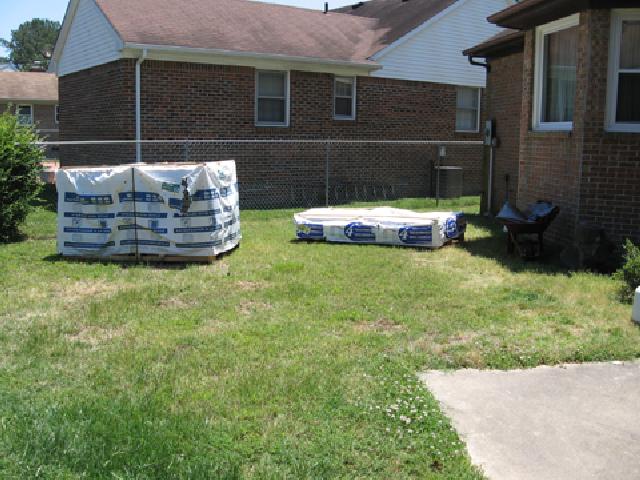 The 2 Creates Containing The New Shed
The 2 Creates Containing The New Shed
|
After several fiascos about the order, it was delivered on June 24th! Two months after I paid for it, and just in time for the temperatures here in Va. Beach to hit 100 deg F. I wasn't about to go out in the sun and that heat. After a week or so, the temps dropped into the mid 80s. I figured it wasn't going to get much cooler than that. So ScottE (my youngest son), Dennis (a good buddy that helps me with all the stupid projects I get myself into), and my wife (Mac) start to work.
|
|
Friday, June 6th, ScottE, Dennis and I start to tear down the old shed. We managed to finish that Friday evening. Next problem was that 3 trees had grown up around the old shed. So Saturday morning we cut the 3 trees down. One of them growing through the old chassis of my '65 Morgan. Over the next 2 weeks I cut up the trash from the trees and put them out for the garbage.
Thursday, June 19th, ScottE and I start to lay out the new foundation area, and start trying to fill in the holes that the dogs had dug under the old shed.
|
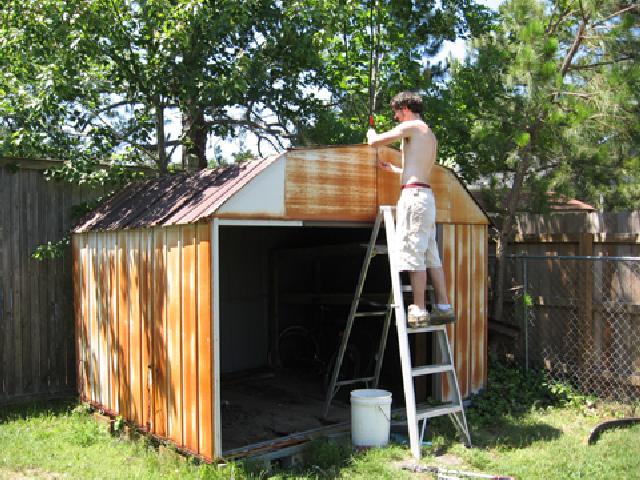 ScottE Starting The Disassembly Of Old Shed
ScottE Starting The Disassembly Of Old Shed
|
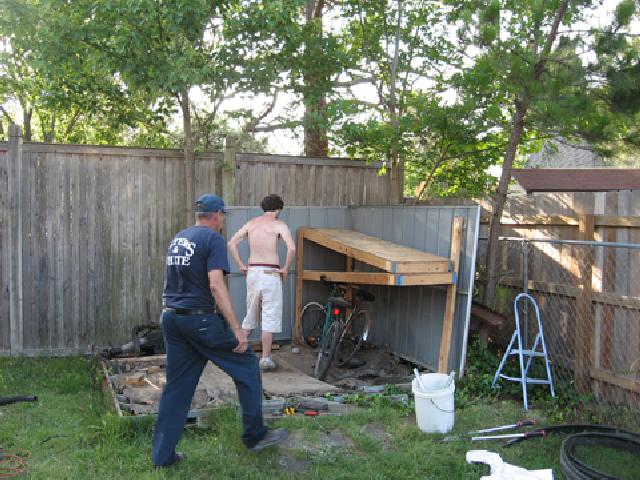 Dennis Arrives and Shed Is Almost Down
Dennis Arrives and Shed Is Almost Down
|
We had calculated how wide and long the area had to be, to be at least 10' wide by 12 ' deep and hold complete cinderblocks. We measured off the size and drove some stakes into the ground to mark the 4 corners. To make sure we were square, we measured the diagonal distance of the stakes, and used a 3', 4', 5' triangle measurements. Once we had the base marked off and square, it was time to lay the timbers.
|
|
Starting along what would be the back wall, we laid the 1st layer of timbers, having to cut one to length. We laid a 3' carpenters level on the timber and pushed dirt under the low end of the timber to raise it to level, and dug out dirt to lower the timber where required. Next, we laid the side timbers, again having to cut to length, and repeated the leveling process. We also checked that the were at right angles to the back timber by measuring off 3 feet from the outside end of the back timber, and 4 feet, from the end of the back wall, on the side timber and marking those measurements. Then we measured the distance from the 2 marks, it should be 5 feet. We adjusted the timbers as necessary. Finally we placed the front timbers using the same method.
|
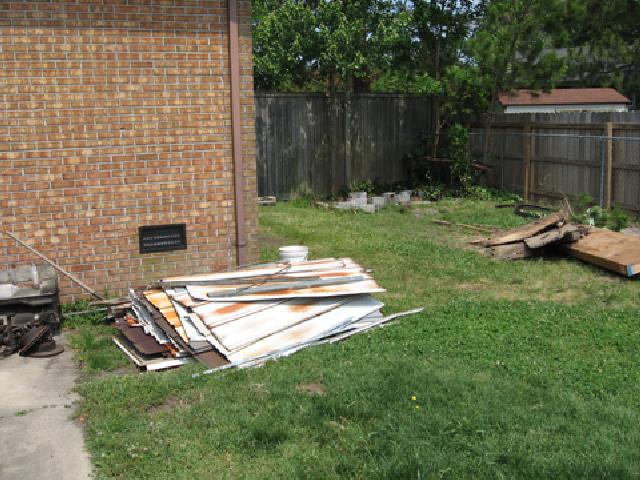 Old Shed Is A Pile Of Rubble
Old Shed Is A Pile Of Rubble
|
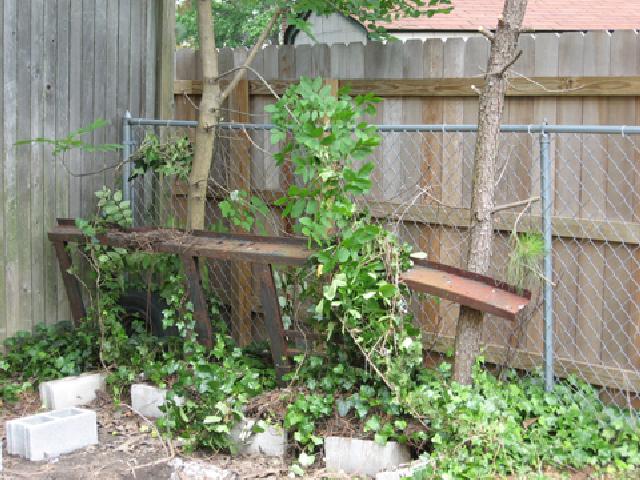 Trees Growing Through My Old Morgan Chassis
Trees Growing Through My Old Morgan Chassis
|
The second layer of timber was set on top of the first layer, using to scrap lengths and a complete timber. We drilled a hole in the timbers and drove a spike through the timbers and into the ground to hold everything in place.
To level the floor, we drove spikes into the ground at each corner and tied string from one spike to the next. Then we placed a line level on the string and adjusted the height of one end of the string to level. So we could get a good idea of how high we had to be. Also we didn't totally fill the enclosure as we needed something to hold the cinderblocks in place.
|
|
Over the next 3 days, ScottE doing the lion's share of the work, we moved over about 50 wheel barrels of crush-n-run, to build up a base for the floor, from the driveway to the shed foundation. We used a stiff rake to move the crush-n-run around and try to level it. When we had the fill to within about an 1 1/2" from the top of the timber it was time to really level base. We used a 2x4 with the carpenters level resting on top to check level. We were able to slide the 2x4 to move to the fill around and get it level.
|
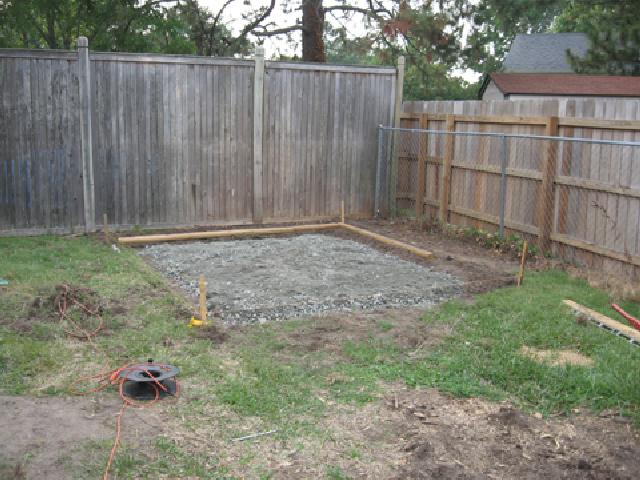 Filling In The Foundation
Filling In The Foundation
|
 Mac Straightening the Vapor Barrier And ScottE Looking on
Mac Straightening the Vapor Barrier And ScottE Looking on
|
After we filled the large sandbox (10' x 12') with about 4" to 5'" of crush-n-run, Dennis brought over a powered tamper to pack the dirt. Again, we checked the base to ensure it was level, and adjusted as necessary.
I had purchased the largest and thickest plastic drop cloth, and laid it over the dirt as a vapor barrier and trimmed to fit.
We finish the base Sunday morning and start to lay the 160 blocks solid cinderblocks. The floor was finished about 5pm Sunday evening.
|
|
We were beat, and took a few days off since the temperature was going back into the mid to high 90s. We watched the weather reports waiting for the next time the temperatures would be in the mid 80s. Thursday, June 26th, the temperatures were supposed to be about 85, and then go up to the high 90s for the next 4 days. In what would be a marathon 10 hr day, we erected the new shed. All went pretty well. But I must say, I'm a little anal retentive, so I wanted to make sure that we had our corners square so that the front would be the proper width. You can actually assemble the shed in about 4 hours.
|
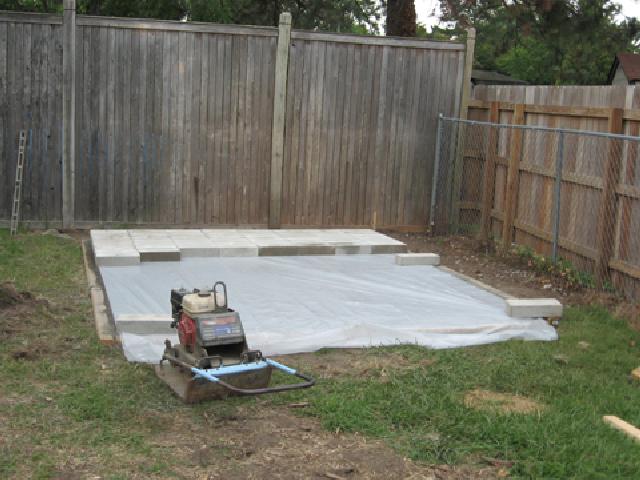 Laying The Cinderblock Floor
Laying The Cinderblock Floor
|
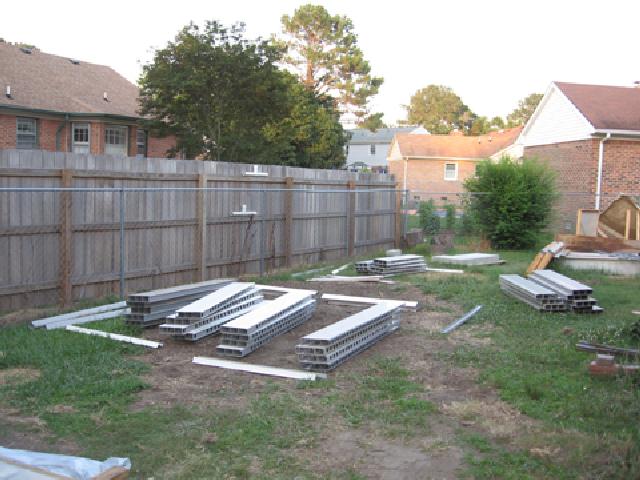 Inventorying Parts
Inventorying Parts
|
Wednesday evening (the 25th) ScottE and I went out to lay out the channels that hold the base of the shed to the floor. To lay the channel required us to drill about 75 holes in the concrete blocks and using the Tapcon screws, screw the channels to the floor. I decided to put 2 screws in each channel and test errect the back wall and a side wall to be sure that we had the channels correct. We spent about 3 hours making sure we had everything square, double checking all the measurements and inventorying shed and the extension parts.
So Thursday morning, we started to test errect the walls, and securing the wall channel to the floor with just one screw in each panel to old it in place. As we laid this out, we kept checking our measurements.
|
|
Luckily the wall panels simply slide together. Once we sure that the walls would fit, we removed the walls so we could finished anchoring the channels to the cinder block floor. We removed each of the anchoring channels and ran a thick bead of calk on the bottom of the channels, and put added more screws to hold them down. This took about 3 hours.
We took a break for about 1 hour to cool off, and grab a sandwich.
Back to work, and rebuild all the walls, about 3 hours of work. Take another 1 hr break to cool off and relax. Back at it to put the roof on and hang the doors.
|
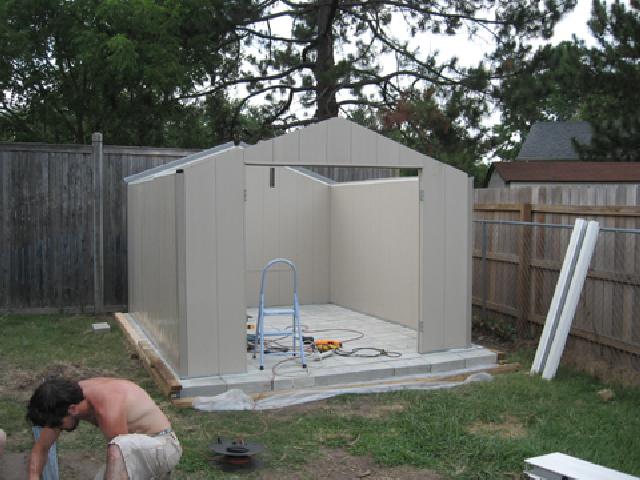 Basic Shed Is Up
Basic Shed Is Up
|
 Roof Going On
Roof Going On
|
We basically finished the shed and picked up all the tools and called it a day about 7:30 Thursday evening. By the end of the day, I was having trouble hold anything. :) I was beat! So was Mac. Dennis showed up after working all day and helped for a couple of hours as we installing the roof. ScottE seemed to be the only one not totally exhausted. But I guess that's the difference between being 24 and 55-60!
I still had to finish installing screws to fix the shed walls to the base channel, and to hold some of the trim to the roof. But that will have to wait for the temps to go back down.
|
|
The temps for the next 4 days are projected to be in the mid to upper 90s. So, hopefully next week the temps will drop again, or I'll see what it's like in the evenings and put the finishing touches on the shed.
Then I get to figure out how to get all the junk that was in the old shed plus the junk in the garage into the new shed.
|
 Basic Shed Complete Except For The Doors
Basic Shed Complete Except For The Doors
|
|
I've got a lot of scrap lumber, from the shed crates, to cut up and put out for the trash. Not to mention a good bit of rock and dirt still in the drive way that we have to shovel and move to the far and back sides of the shed before the job is completely done.
A couple of follow up notes. After the shed was done, I purchased a bag of sandbox sand, and poured the sand into the cracks on the floor between the cinderblocks. Then used a broom to sweep the floor and working the sand into the cracks.
A few days later we had a pretty good rain storm. After the storm I went out to check to see if there was any water in the shed. I noticed that the block floor was damp. I couldn't figure out where the moisture was coming from. The only thing I could think of, was that the rain was flowing down the side of the shed, and getting under the metal strip that that walls attached to. Or it was flowing between the cinderblocks and the yard timbers and then wicking between the cracks in the bricks.
|
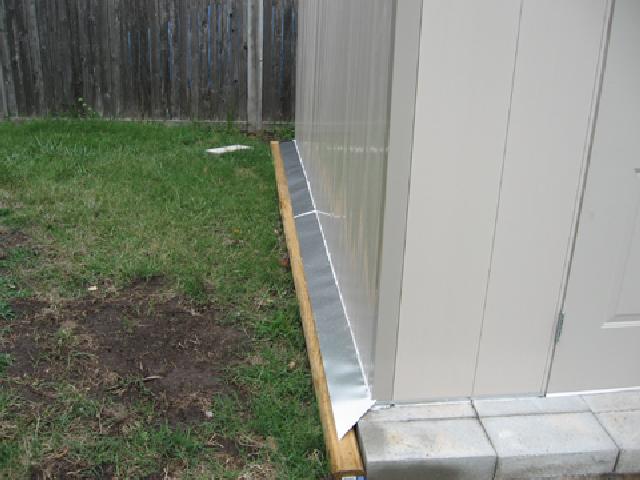 Skirt On Left Side Of Shed
Skirt On Left Side Of Shed
|
After studying the problem for a while, I decided I needed a way to divert any water over the yard timbers. I finally came up with the idea to get some 6" wide metal flashing and make a skirt for the shed. I cut the flashing to length, and then bent a 3/4" lip along one side of the flashing. This would allow me to tuck the flashing between the walls and the metal base channels. Once the flashing was around the shed I ran a bead of calk at the seam of the flashing and the shed walls. I also took a few roofing nails and nailed the outer edge of the flashing to the yard timbers.
With the shed finished, I had two more jobs to do.
|
|
The first, cleaning up the backyard which included getting rid of the old metal erector set shed, and all the junk that I no longer needed that was in the old shed. For that I started talking to people looking for someone that would pick up scrap metal and haul it to the recyclers. I finally found someone to haul all the scrap metal away.
The second job was to clean up the pallets, and rotted wood shelves form the sheds, and clean out the garage and fill the shed. I was going to need some shelving for the sheed. I figured it would cost me at least $40 to make new shelves out of 2x4s and plywood. While I was shoping at Costco one day, with my wife, we found that had some heavy duty metal shelves for about $60. The metal shelves were easy to assemble, easily configurable, quite durable, and each shelf was rated for something like 500 pounds. So I purchased 3 sets and erected them in the shed, and reused on of the wooden shelves from the old shed.
My Garage Before Building the New shed and Cleaning
|
 Left Bay
Left Bay
|
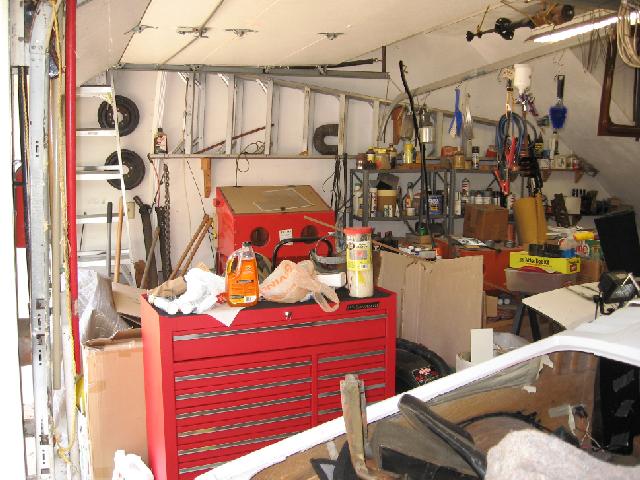 Front of Left Bay
Front of Left Bay
|
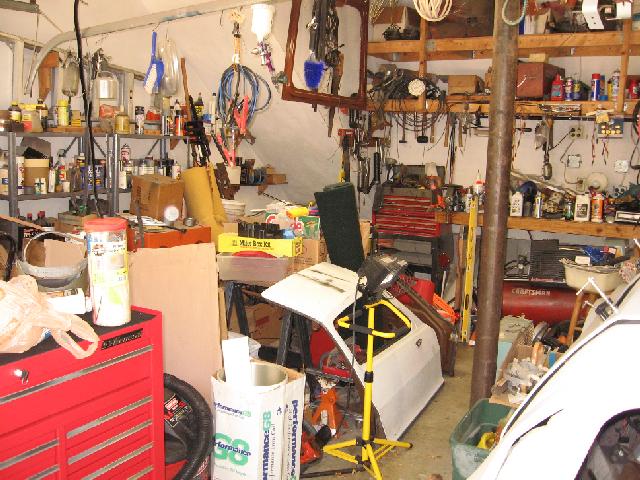 Rear of Left Bay
Rear of Left Bay
|
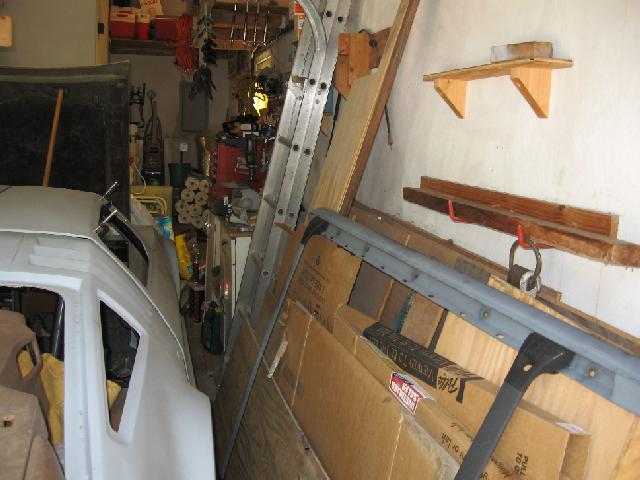 Right Bay
Right Bay
|
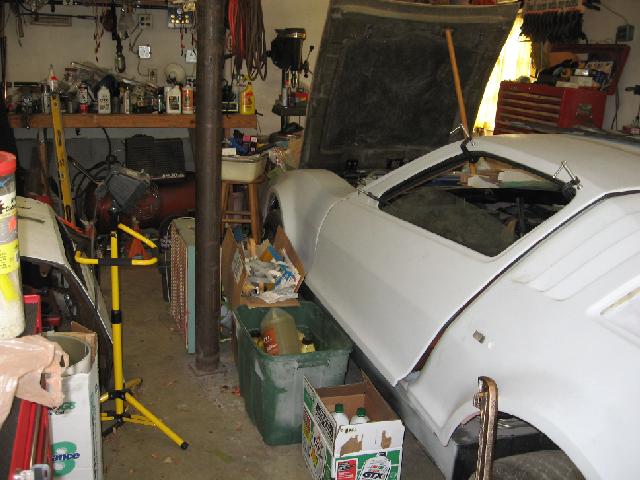 Front of Left Bay
Front of Left Bay
|
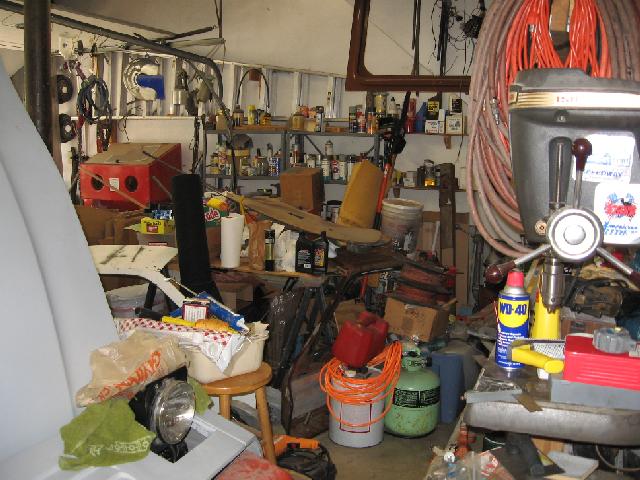 Left Wall
Left Wall
|
 The Shed filled
The Shed filled
|
 Shed 1
Shed 1
|
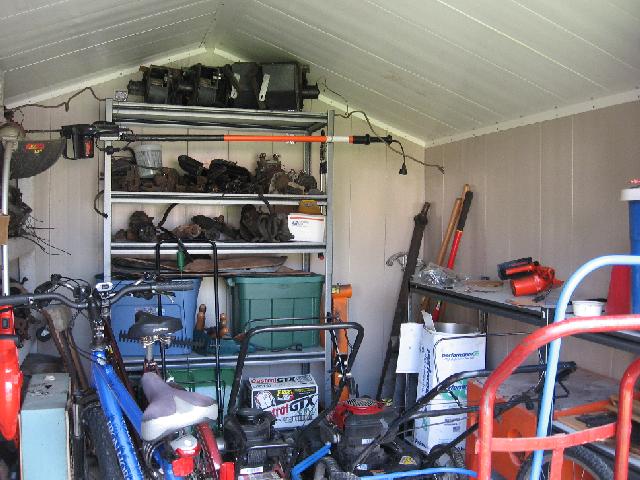 Shed 2
Shed 2
|
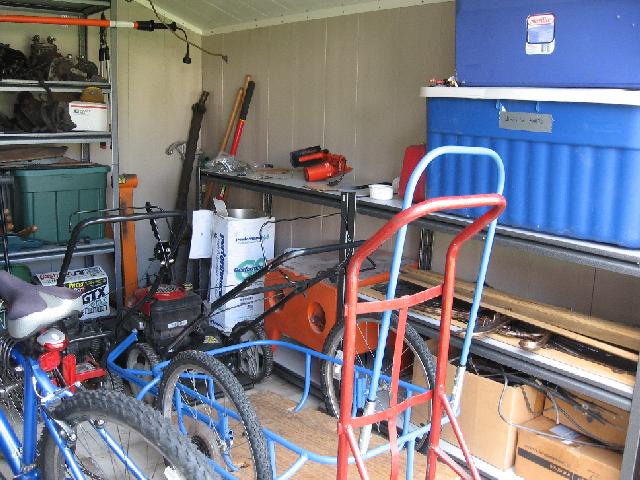 Shed 3
Shed 3
|
 Garage After Cleaning
Garage After Cleaning
|
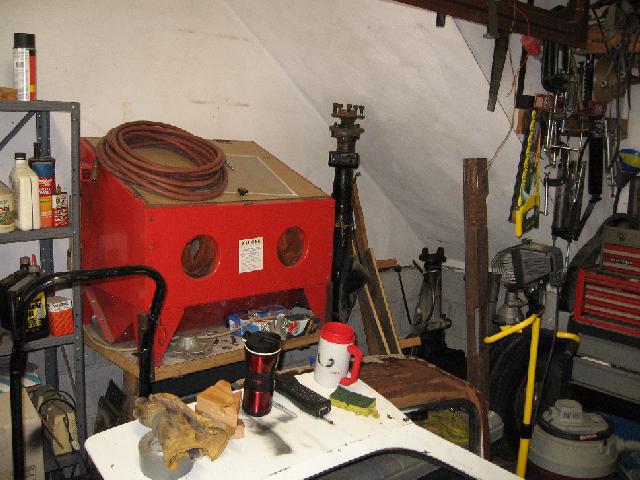 Cleaning Garage 1
Cleaning Garage 1
|
 Cleaning Garage 2
Cleaning Garage 2
|
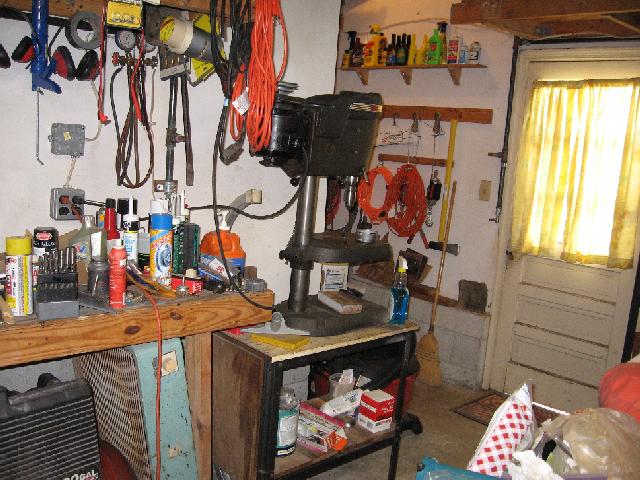 Cleaning Garage 3
Cleaning Garage 3
|
 Cleaning Garage 4
Cleaning Garage 4
|
 Cleaning Garage 5
Cleaning Garage 5
|
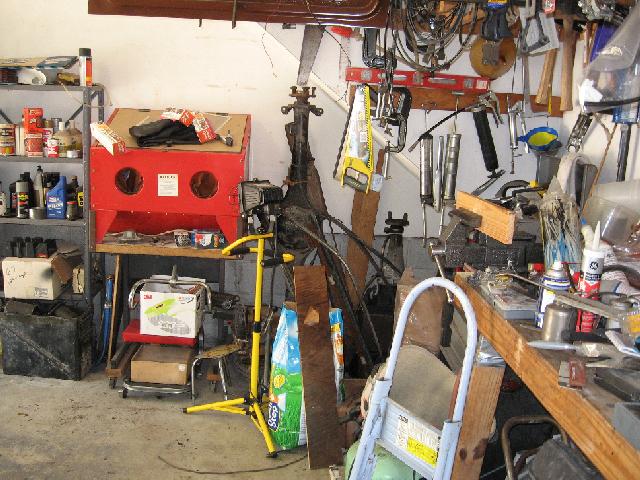 Cleaning Garage 6
Cleaning Garage 6
|
 All in all, a good project. I just wish I could have done it in the fall when it was cooler! And I still have more cleaning to do in the garage!
All in all, a good project. I just wish I could have done it in the fall when it was cooler! And I still have more cleaning to do in the garage!
Return to the Main page
To email me with comments or
questions.
|
 1133 Chatmoss Dr., Va. Beach, Va. 23464; (757) 495-8229
1133 Chatmoss Dr., Va. Beach, Va. 23464; (757) 495-8229
 November 22, 2009.
November 22, 2009.































 All in all, a good project. I just wish I could have done it in the fall when it was cooler! And I still have more cleaning to do in the garage!
All in all, a good project. I just wish I could have done it in the fall when it was cooler! And I still have more cleaning to do in the garage!